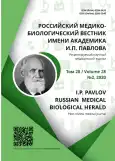Methods of pharmacological correction of intrauterine growth restriction syndrome
- Authors: Klycheva O.I.1, Khuraseva A.B.1
-
Affiliations:
- Kursk State Medical University
- Issue: Vol 28, No 2 (2020)
- Pages: 213-222
- Section: Original study
- URL: https://journals.rcsi.science/pavlovj/article/view/34910
- DOI: https://doi.org/10.23888/PAVLOVJ2020282213-222
- ID: 34910
Cite item
Abstract
Aim. Comparative analysis of the effectiveness of pharmacological correction of intrauterine growth restriction syndrome (IGRS) by monotherapy with diosmin and dipiridamol.
Materials and Methods. Retrospective and prospective examination of 80 pregnant women with singleton pregnancy with gestational age from 28 to 36 weeks with confirmed diagnosis of IGRS of 1 or 2 degree asymmetric form was conducted. 75.0% Of pregnant women that participated in the study, were of the average reproductive age (23-29 years of age). The share of young first-time-mother in I group was 10.0%, in II group – 15.0%, the share of age first-time-mothers was 17.5 and 10.0%, respectively. Extended history taking and history analysis, general clinical and obstetric-gynecological examination were conducted, laboratory and ultrasound methods were used. Newborns were evaluated on Apgar scale at birth and in 5 minutes. In the early neonatal period, inborn and transient pathological syndromes were evaluated.
Results. In patients receiving diosmin (n=40), reduction of the resistance index of the right and left uterine arteries to 0.440±0.004 and 0.460±0.004, respectively, and of the umbilical artery to 0.56±0.02 was achieved, that is lower than in the group of patients taking dipiridamol (n=40). A positive influence of diosmin on the intrauterine condition of the fetus was found that was manifested by its increased compensatory capacities for adaptation to chronic hypoxia in reliably higher percent of cases as compared to dipiridamol. After pharmacological correction, a tendency to normalization of the main parameters of the system of hemostasis was found in higher percent in women taking diosmin. This, in turn, produced a favorable influence on the volume of blood loss in physiological deliveries. Thus, in I group the average amount of blood loss was 180±15 ml, while in II group it was 265±15 ml (р<0.05). However, in operative delivery no such differences were obtained. In I group immediately after deliveries 10.0% of newborns were transferred to the resuscitation and intensive care unit, in II group transfer to resuscitation department was required in 37.5% of infants (<0.05). All the rest of children immediately after birth in the satisfactory condition were placed to one ward with mother, and they did not require resuscitation measures.
Conclusion. Increase in the compensatory capacities of the fetus was shown in the conditions of chronic intrauterine hypoxia in a reliably higher percent of cases after pharmacological correction with diosmin. This, in turn, produced a favorable influence on perinatal outcomes, birth of children with a higher parameters of mass and height and health index.
Full Text
##article.viewOnOriginalSite##About the authors
Olga I. Klycheva
Kursk State Medical University
Author for correspondence.
Email: lyolya.klichiova@yandex.ru
ORCID iD: 0000-0002-1543-3277
SPIN-code: 1318-8058
ResearcherId: AAB-6381-2020
Assistant of the Department of Obstetrics and Gynecology
Anna B. Khuraseva
Kursk State Medical University
Email: lyolya.klichiova@yandex.ru
ORCID iD: 0000-0001-8670-4516
SPIN-code: 5905-9909
ResearcherId: ААВ-6828-2020
MD, PhD, Professor of the Department of Obstetrics and Gynecology
References
- Degtyareva EA, Zakharova OA, Kufa MA, et al. The efficacy of prognosis and early diagnostics of fetal growth retardation. Russian Bulletin of Perinatology and Pediatrics. 2018;63(6):37-45. (In Russ). doi: 10.21508/1027-4065-2018-63-5-37-45
- Klycheva OI, Khuraseva AB. Comparative analysis of pharmacological efficacy of angioprotective agents in the treatment of fetal growth retardation syndrome. Kursk Scientific and Practical Bulletin «Man and His Health». 2017;(3):43-8. (In Russ). doi: 10.21626/vestnik/2017-3/07
- Logutova LS, Petrukhin VA, Akhvlediani KN, et al. Efficacy of angioprotectors in the treatment of placental insufficiency. Russian Bulletin of Obstetrician-Gynecologist. 2010;7(2):45-50. (In Russ).
- Goryunova AG, Simonova MS, Murashko AV. Fetal growth retardation syndrome and adaptation of placenta. V.F. Snegirev Archives of Obstetrics and Gynecology, Russian journal. 2016;3(2):76-80. (In Russ). doi: 10.18821/2313-8726-2016-3-2-76-80
- Strizhenok EA, Gudkov IV, Strachounski LS. Use of Medications in Pregnant Women: Results of the MultiCenter Pharmacoepidemiology Study in Russia. Clinical Microbiology and Antimicrobial Chemotherapy. 2007;9(2):162-75. (In Russ).
- Sukhikh GT. Problema farmakoterapii vo vremya beremennosti. Federal`nyy spravochnik. 2011. P. 253-6. (In Russ).
- Bikmetova ES, Trishkin AG, Artymuk NV. The friquen-cy and risk factors for intrauterine growth restriction. Mat ́ i Dita v Kuzbasse. 2012;(S1):27-31. (In Russ).
- Prodanova EV, Rogozhina IE, Chekhonatskaia ML, et al. Comparative Doppler evaluation of the efficiency of therapy in pregnant women with fetoplacental insufficiency. Russian Bulletin of Obstetrician-Gynecologist. 2011;11(2):79-82. (In Russ).
- Sokolova TM, Marinkin IO, Kuleshov VM, et al. Experience in using dipyridamole in the group of pregnant women with a high risk of perinatal pathology. Meditsinskiy Sovet. 2018;(7):98-100. (In Russ). doi: 10.21518/2079-701X-2018-7-98-100
Supplementary files









